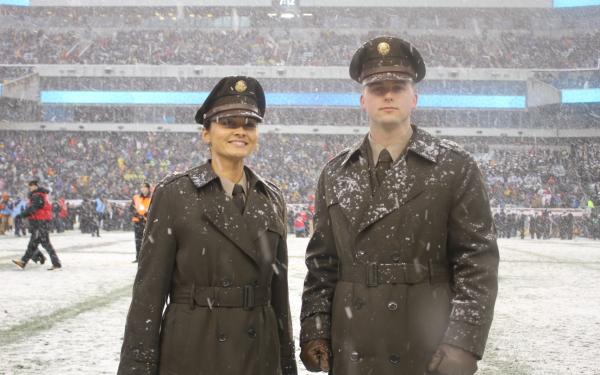
Brought to you by WBIW News and Network Indiana
Last updated on Thursday, April 19, 2018
(WASHINGTON) - The Army is close to making a decision that would buttress an often-bantered cliche “everything old is new again.”

The Pink and Green daily service uniform makes a debut at the Army-Navy Game on Dec. 9, 2017, at Lincoln Financial Field in Philadelphia.
Tom Squitieri of Talk Media News reports, as early as this month, but no later than this fall, the Army expects to decide whether to reinstate the so-called "pink and green" dress uniform as part of a broader effort throughout the Pentagon to boost the public's awareness, appreciation and possible interest in the Army specifically and the military more generally.
The idea to return to the well-regarded and beloved-by-many World War II-era uniforms has strong support among key Army individuals, Pentagon poobahs and some members of Congress -- which ultimately may have a say since any military uniform change costs money.
The chief of staff of the Army is currently scheduled to make the final decision on or before Veterans' Day, Nov. 11, the Army has said.
One key booster is Sergeant Major of the Army Dan Dailey, who wore one version to the Army-Navy football game in Philadelphia last December. The "new" pink and green ensemble also was shown at the Association of the U.S. Army convention last October.
World War II "was a point in history where soldiers were highly respected and there was a sense of nationalism in the country. When you looked at them you said that is an American soldier," Dailey told the Military Times newspaper.
The uniform would replace the current Army Service Uniform -- introduced in 2008 -- which would then transition into a more formal dress uniform.
Dailey declined to comment to Talk Media News and the Army could not provide a timetable for approval or the remaining steps in the approval process.
The Army is also considering a leather jacket and an Ike-style jacket, according to Army news releases and published reports.
Embracing iconic images of the service is critical for the Pentagon as part of its effort to revitalize interest as well as build a broader understanding of the military.
The Navy still uses the familiar Dixie Cup white hat for sailors and is facing Congressional opposition to its plan to eliminate peacoats, both long-time symbols of the sea force.
Each branch of service has a dizzying array of uniforms, and walking the halls of the Pentagon many are obvious. There are a plethora of uniforms, with the variations sometimes being a labyrinth of specialty, deployment, rank, headwear and custom. Some critics have dubbed the military's love affair with uniforms as "50 Shades of Green."
The branches call their uniforms by different names but all branches essentially have a dress uniform for non-combat duty, a workout uniform, an everyday uniform -- now usually a camouflaged variant, that is sometimes referred to as a combat uniform or service uniform -- and a full dress uniform, use for high-level, black-tie style events.
For example, the Navy Service Uniform was introduced in 2008 as the replacement for two Service Uniforms for enlisted sailors: the Winter Blue and Summer White uniforms.
"The most recent change to the Navy's Service Khaki Uniform occurred in 2016. Starting October 1, 2017, the U.S. Navy introduced as a mandatory utility uniform, a multi-color (green, tan, black) digital print camouflage utility uniform. This uniform will replace the current multi-color (blue, grey and black) utility uniform by October 1, 2019," the Navy said in an email.
The Air Force has followed a minimalist approach to its uniform changes, other than adding its camouflaged variant. The Marines were the first to introduce a service-specific camouflaged variant.
The current service Army service uniform was introduced in June 2004. It replaced the Battle Dress Uniform (BDU) and the Desert Camouflage Uniform (DCU) that was first worn in the 1980s and 1990s, the Army said in a news release. Before that, the last significant change was in 1952, when the Army moved to its olive green shade utility uniform that was a mainstay in the Korean and Vietnam wars, according to data on Army websites.
The Army also replaced its dress green uniform in 2014 after 61 years of service with a version of the Army dress blue uniform -- the Army Service Uniform, the Army said in an earlier news release.
Army officers wore the Pink and Green Uniform from the early 1930s to the early 1950s. An Army Times survey in February found more than 70 percent of respondents favored the idea of returning to the World War II uniform.
Each branch is almost always fiercely protective of its uniform. For example, when the Marine Corps moved to highly regarded camouflaged uniform for day work duty, the Army expressed interested in replicating it for its use. To avoid that, the Marines inserted the Marine Corps emblem into the digitized pattern.
That forced the Army to spend millions to develop it own digital camouflage uniform.
Ironically, the Air Force is now considering jettisoning its camouflage uniform and using the Army's version.
1340 AM WBIW welcomes comments and suggestions by calling 812.277.1340 during normal business hours or by email at comments@wbiw.com
© Ad-Venture Media, Inc. All Rights Reserved.